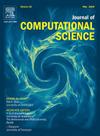POD-Galerkin reduced order model coupled with neural networks to solve flow in porous media
IF 3.1
3区 计算机科学
Q2 COMPUTER SCIENCE, INTERDISCIPLINARY APPLICATIONS
引用次数: 0
Abstract
This paper deals with the numerical modeling of flow around and through a porous obstacle by a reduced order model (ROM) obtained by Galerkin projection of the Navier–Stokes equations onto a Proper Orthogonal Decomposition (POD) reduced basis. In the few existing works dealing with model reduction techniques applied to flows in porous media, flows were described by Darcy’s law and the non linear Forchheimer term was neglected. This last term cannot be expressed in reduced form during the Galerkin projection phase. Indeed, at each new time step, the norm of the velocity needs to be recalculated and projected, which significantly increases the computational cost, rendering the reduced model inefficient. To overcome this difficulty, we propose to model the projected Forchheimer term with artificial neural networks. Moreover in order to build a stable ROM, the influence of unresolved modes and pressure variations are also modeled using a neural network. Instead of separately modeling each term, these terms were combined into a single term, which was modeled using the multilayer perceptron method (MLP). The validation of this approach was carried out for laminar flow past a porous obstacle in an unconfined channel. The proposed ROM coupled with MLP approach is able to accurately predict the dynamics of the flow while the standard ROM yields wrong results. Moreover, the ROM MLP method improves the prediction of flow for Reynolds numbers that are not included in the sampling and for times longer than sampling times. In the final part of the paper, the ROM MLP method was compared with purely data driven methods. It was shown that the MLP method is superior to the purely data driven methods.
结合神经网络的POD-Galerkin降阶模型求解多孔介质流动
本文利用Navier-Stokes方程在固有正交分解(POD)约简基上的伽辽金投影得到的降阶模型(ROM),研究了绕流和流过多孔障碍物的数值模拟。在现有的少数研究多孔介质流动的模型简化技术的著作中,流动是用达西定律来描述的,而非线性Forchheimer项被忽略了。最后一项不能在伽辽金投影阶段以简化形式表示。实际上,在每一个新的时间步长,速度范数都需要重新计算和投影,这大大增加了计算成本,使简化后的模型效率低下。为了克服这一困难,我们提出用人工神经网络对预测的Forchheimer项进行建模。此外,为了建立稳定的ROM,还使用神经网络对未解析模态和压力变化的影响进行了建模。这些项不是单独建模,而是组合成一个单独的项,使用多层感知器方法(MLP)对其建模。该方法在层流通过无约束通道中多孔障碍物的情况下得到了验证。该方法与MLP方法相结合,能够准确地预测流的动态,而标准ROM的预测结果是错误的。此外,ROM MLP方法改善了未包含在采样中的雷诺数的流动预测,并且比采样时间长几倍。在论文的最后,将ROM MLP方法与纯数据驱动方法进行了比较。结果表明,MLP方法优于纯数据驱动方法。
本文章由计算机程序翻译,如有差异,请以英文原文为准。
求助全文
约1分钟内获得全文
求助全文
来源期刊

Journal of Computational Science
COMPUTER SCIENCE, INTERDISCIPLINARY APPLICATIONS-COMPUTER SCIENCE, THEORY & METHODS
CiteScore
5.50
自引率
3.00%
发文量
227
审稿时长
41 days
期刊介绍:
Computational Science is a rapidly growing multi- and interdisciplinary field that uses advanced computing and data analysis to understand and solve complex problems. It has reached a level of predictive capability that now firmly complements the traditional pillars of experimentation and theory.
The recent advances in experimental techniques such as detectors, on-line sensor networks and high-resolution imaging techniques, have opened up new windows into physical and biological processes at many levels of detail. The resulting data explosion allows for detailed data driven modeling and simulation.
This new discipline in science combines computational thinking, modern computational methods, devices and collateral technologies to address problems far beyond the scope of traditional numerical methods.
Computational science typically unifies three distinct elements:
• Modeling, Algorithms and Simulations (e.g. numerical and non-numerical, discrete and continuous);
• Software developed to solve science (e.g., biological, physical, and social), engineering, medicine, and humanities problems;
• Computer and information science that develops and optimizes the advanced system hardware, software, networking, and data management components (e.g. problem solving environments).
 求助内容:
求助内容: 应助结果提醒方式:
应助结果提醒方式:


